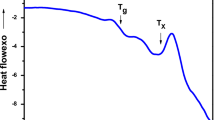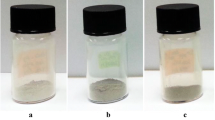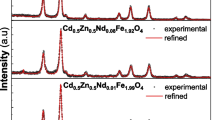Abstract
The effect of glass composition and the presence of CdSe/ZnSe nanoparticles (NPs) on the optical absorption and fluorescence of Sm-doped lead borate glasses are studied. Three sets of glass samples xPbO:(99.5-x) B2O3:0.5Sm2O3, x = 29.5–69.5 mol%, xPbO:(96.5-x) B2O3:0.5Sm2O3: 3CdSe/ZnSe, x = 36.5, and 56.5 mol% are prepared. NPs are grown by annealing these glasses just below the glass transition temperature. Average size of both types of NPs increases with annealing time; however, CdSe NPs grew to a larger size range (2 to 20 nm) compared to ZnSe NPs (1 to 16 nm). We analyzed the hypersensitive transition, intensity parameters, radiative transition probability, stimulated emission cross section (σp), and the area ratio of the electric dipole/magnetic dipole transitions of Sm3+. The intensity parameters show a minimum at 11 h annealing for 36.5 mol% and a maximum for the same annealing duration in 56.5 mol% PbO containing CdSe NPs. The σp for 56.5 mol% of PbO with CdSe NPs is found to be a maximum when the average NP size is around 14 nm. ZnSe NPs containing glasses also show significant changes in σp when the average particle size is ~16 nm, for 36.5 mol% PbO. Our results suggest that the optical properties of Sm3+ in lead borate glasses are sensitive to its electronic environment which can be modified by varying the base glass composition and/or incorporating large NPs of CdSe/ZnSe. The large σp values that we observe for some of the glass compositions make them attractive materials for photonic devices and photovoltaic applications.

Graphical abstract













Similar content being viewed by others
References
Ali N, Hussain A, Ahmed R, Wang MK, Zhao C, Ul Haq B, Fu YQ (2016) Advances in nanostructured thin film materials for solar cell applications. Renew Sust Energ Rev 59:726–737
Barnes WL, Dereux A, Ebbesen TW (2003) Surface plasmon subwavelength optics. Nature 424:824–830
Boehm L, Reisfeld R, Spector N (1979) Optical transitions of samarium(3+) in oxide glasses. J Solid State Chem 28:75–78
Carnall WT, Gruen DM, McBeth RL (1962) Near- infrared transitions of the trivalent lanthanides in solution. I. Praseodymium (III), neodymium (III), samarium (III), and europium (III) ions. J Phys Chem 66:2159–2164
Chi-Shun T, Chen C-S, Chen P-Y, Wei H-H, Schmidt VH, Lin C-Y, Anthoniappen J, Lee J-M (2016) Enhanced photovoltaic effects in A-site samarium doped BiFeO3 ceramics: the roles of domain structure and electronic state. J Eur Ceramic Soc 36(5):1149–1157
Costa VC, Shen Y, Bray KL (2002) Luminescence properties of nanocrystalline CdS and CdS:Mn2+ doped silica-type glasses. J Non-Cryst Solids 304:217–223
Digonnet MJ (ed) (1993) RE doped fiber lasers and amplifiers. Dekker, New York
Dyrba M, Miclea P T, Schweizer S (2010) Spectral down-conversion in Sm-doped borate glasses for photovoltaic applications. Photonics for solar energy systems III, in: R.B. Wehrspohn, A. Gombert (Eds.), in: Proceedings of SPIE, 7725: 77251D/1-77251D/7.
Edgar A, Varoy CR, Koughia C, Okada G, Belev G, Kasap S (2013) High-resolution X-ray imaging with samarium-doped fluoroaluminate and fluorophosphate glass. J Non-Cryst Solids 377:124–128
George HB, Vira C, Stehle C, Meyer J, Evers S, Hogan D, Feller S, Affatigato M (1999) A structural analysis of the physical properties of bismuth and lead based glasses. Phys Chem Glasses 40(6):326–332
Hari Babu B, Ravi Kanth Kumar VV (2014) White light generation in Ce3+-Tb3+-Sm3+ codoped oxyfluoroborate glasses. J Lumin 154:334–338
Hayakawa T, Ooishi H, Nogami M (2001) Optical bistability of stimulated-emission lines in Sm3+-doped glass microspheres. Opt Lett 26(2):84–86
Hayes TM, Persans PD, Filin A, Peng C (2004) Bonding changes during the growth of CdSe nanoparticles in glass. J Non-Cryst Solids 349:35–37
Jamalaiah BC, Kumar JS, Babu AM, Suhasini T, Moorthy LR (2009) Photoluminescence properties of Sm3+ in LBTAF glasses. J Lumin 129(4):363–369
Jiménez JA, Lysenko S, Liu H, Sendova M (2011) Luminescence of trivalent samarium ions in silver and tin co-doped aluminophosphate glass. Opt Mater 33:1215–1220
Jørgensen CK (1971) Modern Aspects of Ligand Field Theory. North-Holland, Amsterdam
Jørgensen CK (1962) Absorption spectra and chemical bonding in complexes. Pergamon, New York
Jørgensen CK, Judd BR (1964) Hypersensitive pseudoquadrupole transitions in lanthanides. Mol Phys 8:281–290
Judd BR (1956) The structures of the ground multiplets of certain rare earth ions. Proc Phys Soc Sec A 69(2):157–164
Judd BR (1962) Optical absorption intensities of rare earth ions. Phys Rev 127(3):750–761
Kenyon AJ (2002) Recent developments in rare earth doped materials for optoelectronics. Prog Quantum Electronics 26:225–284
Kityk IV, Isylak J, Benet S, Dorosz D, Kucharski J, Krasowski J, Sahraoui B (2002) Synthesized rare earth oxide doped glasses for non-linear optics. J Appl Phys 92:2260–2268
Koughia C, Edgar A, Varoy CR, Okada G, VonSeggern H, Belev G, Kim C, Sammynaiken R, Kasap S (2011) Samarium-doped fluorochlorozirconate glass-ceramics as red-emitting X-ray phosphors. J Am Ceram Soc 94:543–550
Krause S, Pfau C, Dyrba M, Miclea PT, Schweizer S (2014) On the role of the network modifier PbO in Sm3+-doped borate glasses. J Lumin 151:29–33
Lakshminarayana G, Yang R, Qiu JR, Brik MG, Kumar GA, Kityk IV (2009) White light emission from Sm3+/Tb3+ codoped oxyfluoride aluminosilicate glasses under UV light excitation. J Phys D Appl Phys 42:015414/1–015414/12
Maheshvaran K, Linganna K, Marimuthu K (2011) Composition dependent structural and optical properties of Sm3+ doped boro-tellurite glasses. J Lumin 131:2746–2753
Mallur SB, Czarnecki T, Adhikari A, Babu PK (2015) Compositional dependence of optical band gap and refractive index in lead and bismuth borate glasses. Mater Res Bull 68:27–34
Meera BN, Sood AK, Chandra Bhas N, Ramakrishna J (1990) Raman study of lead borate glasses. J Non-Cryst Solids 126:224–230
Naranjo LP, de Araujo CB, Malta OL, Cruz PAS, Kassab LRP (2005) Enhancement of Pr3+ luminescence in PbO-GeO2 glasses containing silver NPs. Appl Phys Lett 87:241914/1–241914/3
Nielsen WC, Koster FG (1963) Spectroscopic coefficients for the pn, dn, and fn configurations. The MIT Press, Cambridge
Norris DJ, Bawendi MG (1996) Measurement and assignment of the size-dependent optical spectrum in CdSe quantum dots. Phys Rev B Condens Matter 53(24):16338–16346
Norris DJ, Sacra A, Murray CB, Bawendi MG (1994) Measurement of the size dependent hole spectrum in CdSe quantum dots. Phys Rev Lett 72(16):2612–2615
Ofelt G (1962) Intensities of crystal spectra of rare-earth ions. J Chem Phys 37(3):511–520
Okada G, Ueda J, Tanabe S, Belev G, Wysokinski T, Chapman D, Tonchev D, Kasap S (2014) Samarium-doped oxyfluoride glass-ceramic as new fast erasable dosimetric detector material for microbeam radiation cancer therapy applications at Canadian synchrotron. J Am Cer Society 97(7):2147–2153
Ooi HG (2016) Optical Properties of Dy-doped Lead and Bismuth Borate Glasses-Effect of Glass Composition, Metal and Semiconducting Nanoparticles, MS Dissertation, Department of Physics, Western Illinois University
Peacock RD (1975) The intensities of lanthanide f-f transitions. Structure and Bonding, Rare Earths, Springer 22:83–122
Persans PD, Hayes TM, Lurio LB (2004) Size-dependent composition of semiconductor NPs in glass. J Non-Cryst Solids 349:315–318
Pisarska J, Pisarski W A (2011) Lanthanide-Doped Lead Borate Glasses for Optical Applications (Materials Science and Technologies) ISBN-10: 1616682922, ISBN-13: 978–1616682927
Prasad PN (2004) Nanophotonics. Wiley, New York
Qu L, Peng X (2002) Control of photoluminescence properties of CdSe nanocrystals in growth. J Am Chem Soc 124(9):2049–2055
Rachkovskaya GE, Zakharevich GB, Yumashev KV, Malyarevich AM, Gaponenko MS (2004) Glasses with lead sulfide nanoparticles for laser technologies. Glas Ceram 61:331–333
Rada S, Pascuta P, Rada M, Culea E (2011) Effects of samarium (III) oxide content on structural investigations of the samarium-vanadate-tellurate glasses and glass ceramics. J Non-Cryst Solids 357:3405–3409
Reisfeld R (1975) Radiative and nonradiative transitions of rare earth ions in glasses. Structure and Bonding, Springer-Verlag, Berlin 22:123–175
Reisfeld R, Eckstein Y (1972) Absorption and emission spectra of thulium and erbium in borate and phosphate glasses. J Solid State Chem 5:174–185
Reisfeld R, Jørgensen CK (1977) Lasers and excited states of rare earths. Springer, Berlin
Reisfeld R, Jørgensen CK (1987) Excited state phenomena in vitreous materials. Handbook on the physics and chemistry of Rare earths 9:1–90
Saisudha MB, Ramakrishna J (1996) Effect of host glass on the optical absorption properties of Nd3+, Sm3+, and Dy3+ in lead borate glasses. Phys Rev B 53(10):6186–6196
Seshadri M, Rao KV, Rao JL, Ratnakaram YC (2009) Spectroscopic and laser properties of Sm3+ doped different phosphate glasses. J Alloys Compd 476:263–270
Shen LF, Chen BJ, Pun EYB, Lin H (2015) Sm3+−doped alkaline earth borate glasses as UV-visible photon conversion layer for solar cells. J Lumin 160:138–144
Sinha SP (1966) Complexes of the rare earths. Pergamon Press, Oxford
Srivastava P, Rai SB, Rai DK (2004) Optical properties of Sm3+ doped calibo glass with addition of lead oxide. Spectrochim Acta A Mol Biomol Spectrosc 60:637–642
Steudel F, Dyrba M, Schweizer S (2012) Fluorescent borate glass superstrates for high efficiency CdTe solarcells. Photonics for solar energy systems IV: Wehrspohn R B, Gombert A (Eds.) Proceedings of SPIE, 8438: 843803/1–843803/7
Sudhakar KSV, Srinivasa Reddy M, Srinivasa Rao L, Veeraiah N (2008) Influence of modifier oxide on spectroscopic and thermoluminescence characteristics of Sm3+ ion in antimony borate glass system. J Lumin 128(11):1791–1798
Tanabe S, Ohyagi T, Soga N, Hanada T (1992) Compositional dependence of Judd-Ofelt parameters of Er3+ ions in alkali borate glasses. Phys Rev B 46:3305–3310
Tirtha S, Karmakar B (2009) Nanosilver enhanced upconversion fluorescence of erbium ions in Er3+: Ag-antimony glass nanocomposites. J Appl Phys 105:013102/1–013102/8
Van Deun R, Binnemans K, Gorller-Walrand C, Adam Jean-Luc (1999) Spectroscopic properties of trivalent samarium ions in glasses. Proceedings of SPIE-The International Society for Optical Engineering, 3622 (Rare-Earth-Doped Materials and Devices III), 175–181
Yamane M, Asahara Y (2000) Glasses for photonics. Cambridge University Press, Cambridge
Yu WW, Qu L, Guo W, Peng X (2003) Experimental determination of the extinction coefficient of CdTe, CdSe and CdS nanocrystals. Chem Mater 15:2854–2860
Acknowledgements
TEM, optical absorption, and fluorescence measurements were carried out at the Frederick Seitz Materials Research Laboratory Central Facilities, University of Illinois, Urbana-Champaign, which are partially supported by the US Department of Energy under grants DE-FG02-07-ER46453 and DE-FG02-07- ER46471.
Author information
Authors and Affiliations
Corresponding author
Ethics declarations
Conflict of interest
The authors declare that they have no conflict of interest.
Electronic supplementary material
ESM 1
(DOCX 354 kb)
Rights and permissions
About this article
Cite this article
Mallur, S.B., Heidorn, W.D., Fatokun, S.O. et al. The influence of CdSe and ZnSe nanoparticles on the optical properties of Sm3+ ions in lead borate glasses. J Nanopart Res 19, 102 (2017). https://doi.org/10.1007/s11051-017-3795-9
Received:
Accepted:
Published:
DOI: https://doi.org/10.1007/s11051-017-3795-9




